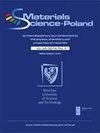AISI 4140钢硬车削时切削速度和进给速率对刀具寿命影响的模拟
IF 1.3
4区 材料科学
Q4 MATERIALS SCIENCE, MULTIDISCIPLINARY
引用次数: 0
摘要
研究了不同切削条件下Al 2o3 +TiC和TiN+AlCrN刀具在车削AISI 4140钢时的寿命性能。刀具寿命模型以最大表面粗糙度为0.8 μm作为刀具寿命标准。利用泰勒公式得到了切削速度和进给速度与刀具寿命之间的关系。通过蒙特卡罗仿真,评价了切削速度和进给速度对刀具寿命的敏感性。结果表明,高切削速度和进给速度的车削会降低两种刀具的寿命。在不同的切削速度和进给速率下,Al 2o3 +TiC的刀具寿命优于TiN+AlCrN。此外,仿真结果表明,当进给速度保持在0.06 mm/rev时,在220 m/min以下和高于220 m/min的切削速度下,Al 2o3 +TiC的平均刀具寿命比TiN+AlCrN的平均刀具寿命高出约40%。同样,当切削速度保持在220 m/min时,当进给量低于和高于0.06 mm/rev时,Al 2o3 +TiC的平均刀具寿命比TiN+AlCrN的平均刀具寿命高出约45%。不同切削速度对刀具寿命值的影响比不同进给速度对刀具寿命值的影响更敏感。本文章由计算机程序翻译,如有差异,请以英文原文为准。
Simulation of the influence of cutting speed and feed rate on tool life in hard turning of AISI 4140 steel
Abstract Tool life performances of Al 2 O 3 +TiC and TiN+AlCrN tool inserts were investigated experimentally under different cutting conditions in turning AISI 4140 steel. The tool life model is defined in accordance with a maximum surface roughness of 0.8 μm for the tool life criterion. The relationships between machining factors (i.e., cutting speed and feed rate) and tool life were obtained by Taylor’s formular. The sensitivity of cutting speed and feed rate to tool life was evaluated by Monte Carlo simulation. The results showed that turning with high cutting speeds and feed rates decreased the tool life of both inserts. At different cutting speeds and feed rates, Al 2 O 3 +TiC exhibited better tool life performance than TiN+AlCrN. In addition, the simulation results indicated the average tool life of Al 2 O 3 +TiC was approximately 40% greater than that of TiN+AlCrN by varying cutting speeds below and above the cutting speed of 220 m/min while keeping the feed rate constant at 0.06 mm/rev. Similarly, when keeping the cutting speed constant at 220 m/min, the average tool life of Al 2 O 3 +TiC was approximately 45% greater than that of TiN+AlCrN by varying feed rates below and above the feed rate of 0.06 mm/rev. Variations of tool life values by varying cutting speeds were more sensitive than those by varying feed rates for both tool inserts.
求助全文
通过发布文献求助,成功后即可免费获取论文全文。
去求助
来源期刊

Materials Science-Poland
MATERIALS SCIENCE, MULTIDISCIPLINARY-
自引率
18.20%
发文量
18
期刊介绍:
Material Sciences-Poland is an interdisciplinary journal devoted to experimental research into results on the relationships between structure, processing, properties, technology, and uses of materials. Original research articles and review can be only submitted.
 求助内容:
求助内容: 应助结果提醒方式:
应助结果提醒方式:


